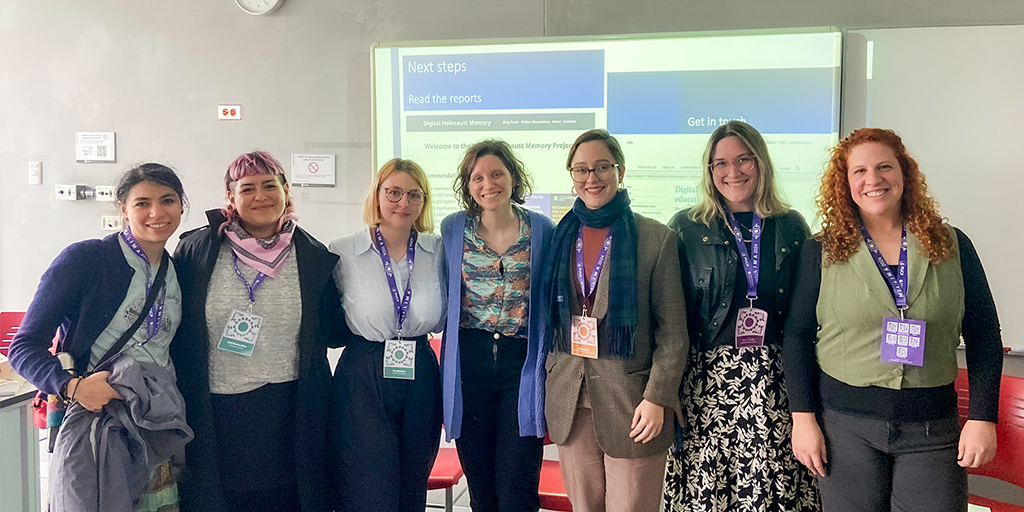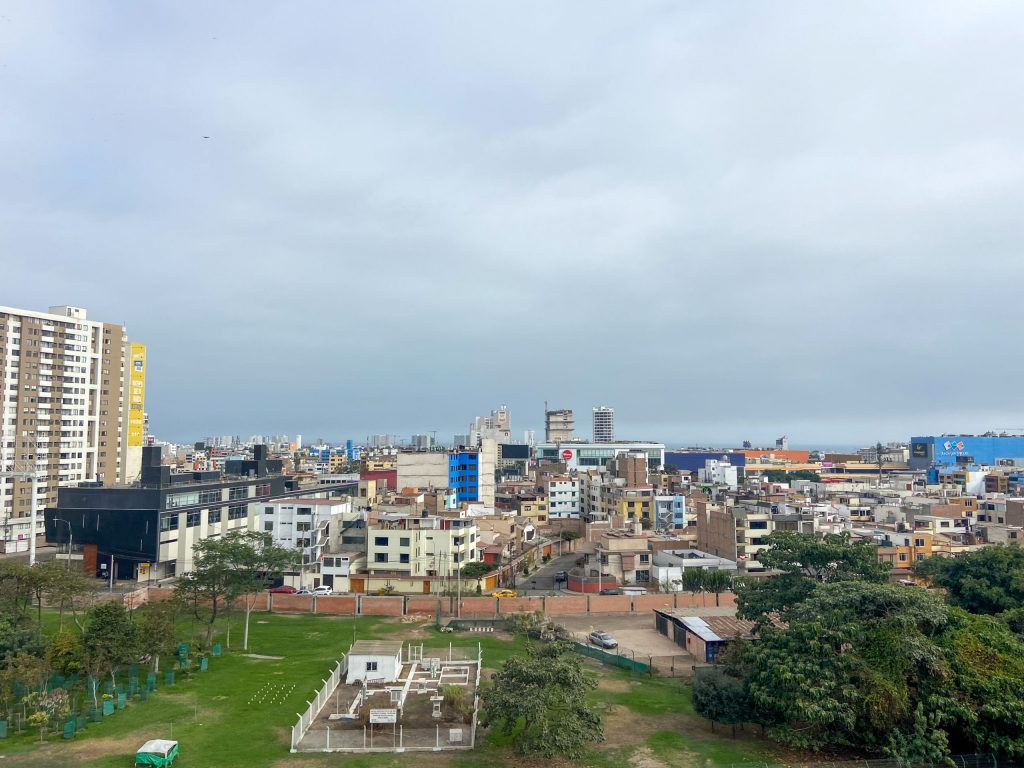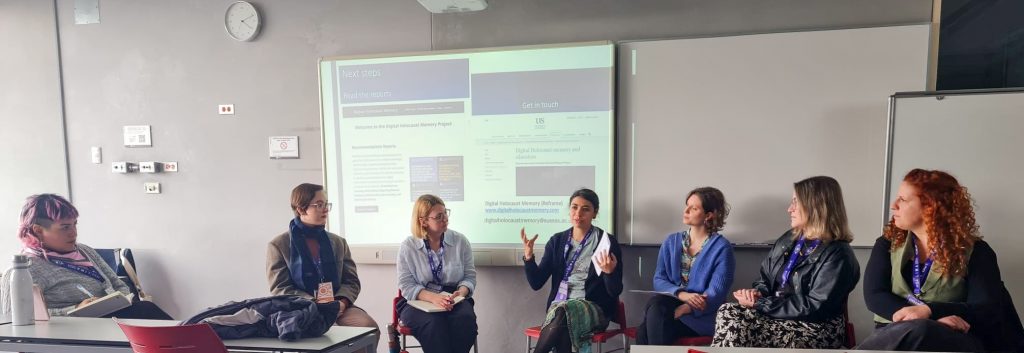
Listening in Latin America: Digital Holocaust Memory and Education in Brazil, Argentina and Ecuador
by Dr Kate Marrison
Research fellow Dr Kate Marrison recently returned from Lima where she held a roundtable discussion with professionals working in the field of Holocaust education from Brazil, Argentina and Ecuador. This is what she found out.
While there is a proliferation of scholarly interest in the digital development of Holocaust commemoration and education across Europe and the US, little attention has been paid to this work in Latin America.
Last month the Memory Studies Association annual conference took place in Lima, so we took the opportunity to bring together colleagues to discuss their work within Holocaust organisations in Argentina, Brazil, and Ecuador.

Pontificia Universidad Católica del Perú, Lima, Perú.
To kick off, I asked contributors what digital interventions they had brought to their organisations and what are the challenges and opportunities they bring.
Participants discussed some fascinating examples of their practice. They included a virtual tour of Museo del Holocausto de Buenos Aires and the first survivor interactive biography to be recorded in Spanish as part of the Dimensions in Testimony (DiT) project in collaboration with The Latin American Network for Education on the Shoah.
Examples from Brazil included open-access online educational materials created by Museu do Holocausto de Curitiba, as well as their activities on social media platforms including Instagram, Facebook, X, TikTok and YouTube.

From left to right. Malú Machuca Rose, Bárbara Deoti Silva Rodrigues, Kate Marrison, Gabriela Steinitz, Mariel Goisen, Laura Nicoli Kullock and Brenda Ficher.
Online communication became a central thread. All participants had utilised various platforms as tools for teaching, prompting in-person visits and reaching global audiences beyond the physical museum.
Brenda Ficher, from San Martín University in Argentina, shared how an Instagram initiative called Resistant Women became a physical exhibition at Museo del Holocausto Buenos Aires demonstrating how social media actively informs and impacts the museum rather than simply acting as a mirror of the material content online.
While social media is an indispensable tool, participants also acknowledged the risks of increasing antisemitism, and coded denial and distortion that penetrate online discourses. They also pose challenges to the staff maintaining the accounts.
We run this project because we believe in the relevance of our work. It can be gratifying, but it is a barrier long-term: trying to find the time to do research, writing, editing on top of full-time jobs.
Bárbara Deoti Silva Rodrigues, co-director of NEPAT, an independent initiative of female historians in Brazil, commented how they have taken a ‘trial and error’ approach on Instagram and YouTube.
“There was definitely a learning curve as we figured out what worked for us, our audience, and social media platforms,” she said. She noted how difficult it is to create content and sustain the accounts with only three unpaid members of staff.
“We run this project because we believe in the relevance of our work,” said Bárbara. “While it can be gratifying, it is without doubt a barrier for long-term sustainability: trying to find the time to do everything – research, writing, editing, management, and upkeep with new trends and strategies – on top of full-time jobs and academic commitments.”
This is a wider problem within the museum and education sector globally, as historians, educators and administrators are under pressure to adopt online communication methods without training or online safeguarding (read more in our recommendations).
Laura Nicoli Kullock, Communications Coordinator at Museu do Holocausto de Curitiba said that their TikTok account (the first in the sector in Latin America) has received more than 1.1million likes, but it can be challenging to maintain. It’s fast-paced and labour intensive as “the rules change” around topics and trends as they are reshared, repackaged and remediated, she explained, particularly through TikTok’s use of ‘sound’, ‘duets’ and ‘stitches’.
She said that post October 7, the account received backlash for posts which incorporated viral sound clips for comic effect – an approach not previously considered controversial.
Indeed, contributors acknowledged a kind of policing within the comments and an increasing demand for “sensible” content on their social media channels. This raises questions around current (inter-)national attitudes to incorporating social media into Holocaust education.
While the discussion inevitably moved onto the global rise of antisemitism and far-right extremism online, it also zoomed in on the local level. In Brazil it was highlighted that there is a significant strand of anti-intellectualism directed at universities which informs the kind of work emerging regionally.
Many participants expressed a sense of isolation not only from the wider sector but within Latin America itself. They highlighted the establishment of Red LAES (The Latin American Network for Shoah Teaching) as a critical step to building connections between organisations in Argentina, Chile, Costa Rica, Guatemala, Mexico, Panama, Paraguay, Peru, Puerto Rico and Uruguay.
If you could have one wish…
“Consistent funding is essential to turn NEPAT into a full-fledged institution, shift staff from voluntary to secure, paid positions and ensure long-term sustainability.”
— Bárbara Deoti Silva Rodrigues, NEPAT
“Funding for online courses would be transformational – particularly around lesser-known histories in Ecuador and Bolivia.”
— Gabriela Steinitz, from the Casa Museo Trude Sojka in Ecuador
“Connectivity and accessibility, particularly in providing mobile phones and tablets for educational purposes.”
— Brenda Ficher, San Martín University
“Funding to provide open-access free platforms.”
— Mariel Goisen from the Museo del Holocausto Buenos Aires
“Funding to hire more people and lead outreach initiatives in schools.”
— Laura Nicoli Kullock, Museu do Holocausto de Curitiba
To focus on this field of work beyond the UK, Europe and the US is vital. Without a comprehensive effort to engage in dialogues and to enhance digital literacies within Holocaust organisations globally, it will be impossible to move beyond a fragmentary, experimental digital memoryscape.
Special thanks to the Memory Studies Association and Pontificia Universidad Católica del Perú for allowing us to host this roundtable discussion as part of their annual conference. We also extend our sincere thanks to Malú Machuca Rose for providing translations.
The Landecker Digital Memory Lab secured funding from the Arts and Humanities Research Council’s Impact Acceleration Account, Higher Education Innovation Fund and the Weidenfeld Institute for Jewish Studies, University of Sussex to support colleagues from Holocaust museums and institutions within Latin America to participate in the event.
Want to know more?
Read about our workshop with young people on Holocaust education and social media
And another with intergovernmental organisations, policymakers and funders